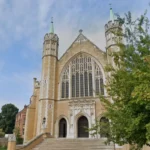Ernest Meade Smythe was born on 25 March 1904 in Ealing, Middlesex, England, and he died on 9 July 1975 at the age of 71 in St Columb Major, Cornwall, England. He was an English cricket player who played the game domestically at the level for teams like Bengal Governor’s XI in the season of 1930/31 and Devon during the year 1928. During Smythe’s short first-class cricket career, he appeared in only one match. He was at 3.50 with the bat, 7 runs on board, best of 6 runs. While bowling, he delivered 54 balls and gained 1 wicket with 19.00 being the average, the best being 1/9. Throughout his career, Smythe neither attained any five-wicket hauls nor participated in ten-wicket matches neither had catches or stumping under his belt.
Who Was Ernest Smythe?
Ernest Meade Smythe was an English cricketer and Indian Army officer whose life spanned several dimensions of service and sport. Though details on his batting and bowling styles are unknown, Smythe made significant contributions to cricket. A native of Ealing, Middlesex, England, Smythe received his early education at the Allhallows School in Devon.
Early Cricket Life
He first played for Devon in the 1928 Minor Counties Championship. In the only game he played for his team, he played three matches against Kent Second XI and Surrey Second XI as well as against Cornwall. That alone increased his popularity and status among the English domestic cricket fraternity and that’s where his career came to an end. Ernest started his career with a lot of talent. He has been an icon for many generations.
First-Class Cricket
In November 1930, Smythe played only one first-class match for the Bengal Governor’s XI against Maharaj Kumar of Vizianagram’s XI at Eden Gardens, Calcutta. His play in this game reflected both the promise and problems that cricketers faced during early 20th-century India. In the first innings of Bengal Governor’s XI, Smythe managed to score only 1 run and was dismissed by Ghulam Mohammad. In the second innings, he scored 6 runs before being dismissed by Mushtaq Ali. As a bowler, Smythe bowled 54 balls, and took 1 wicket with a bowling average of 19.00 where he dismissed C.R. Nayudu off just 19 runs. During his only first-class game, Smythe did not get any five-wicket hauls or ten-wicket matches.
Service in the Military
The World War II break brought Smythe out of cricket into military service. In February 1942, he was drafted into the Indian Army on an emergency commission and became a 2nd Lieutenant. This formed a very important chapter in his life, during which he gained great repute outside the cricketing field.
Later Life and Legacy
Ernest Meade Smythe died on 9 July 1975 at St Columb Major, Cornwall, England. Even though the cricketing career of Ernest Meade Smythe was short, it follows the history of early 20th-century cricketers who worked on and off the ground, with the weight of change facing them in the world around them.
What was the role of Ernest Meade Smythe in cricket?
Ernest Meade Smythe was an English cricketer who played for Minor Counties Championship and had a very short first-class career, playing for Bengal Governor’s XI in just one game during the 1930/31 season. Being a talented person, he has an integral part in cricket.
How did Smythe do in his single first-class match?
In Bengal Governor’s XI first-class game, Ernest Meade Smythe scored 1 run in the first innings and 6 runs in the second innings at an average of 3.50 for Bengal Governor’s XI. He also bowled one wicket for 19 runs at an average of 19.00.
Did Ernest Meade Smythe ever play other than first-class games?
Apart from that, he also represented the Devon side three times in the Minor Counties Championship, and outside of the country, he only played in one first-class game when he was on a visit to India, playing for Bengal Governor’s XI in 1928.
What did Smythe do during the World War?
In World War II, he was mobilized in February 1942 to Indian Army service; there, he was commissioned as a 2nd Lieutenant.
When and where did Ernest Meade Smythe die?
Ernest Meade Smythe died 9 Jul 1975 at St Columb Major, Cornwall, England.











